
Tweet Volume and Market Behavior
An Analysis of Tweets about Gold
July 2014
Introduction
The ability to monitor public commentaries about investments via Twitter naturally leads to many questions about correlations between tweets and asset price behavior. This study examines the relationship between the volume of tweets about gold and daily gold price returns as well as daily gold price volatility. The period under study is June 30, 2012 - June 30, 2014.
Tweets
Twitter's API provided a random sample of tweets that were authored by a select group of about 150 tweeters. These tweeters included media sources such as The Wall Street Journal, financial blogs such as Seeking Alpha and financial market commentators such as Keith McCullough. All tweets that occur from the previous day after 15:00 GMT, Day 1, to those that occur before 15:00 GMT on the next day, Day 2, are considered contemporaneous with the gold price fixing of Day 2. The logic is that any thoughts expressed after 15:00 GMT would be discounted in the closing price the following day.
The "gold_load.r" file reads the tweets provided by Twitter's API and filters out only those authored by the select group of tweeters. It then filters out those that mention "gold", "GLD", "IAU" or "precious metals". The dataframe "goldtweets" contains all of these tweets. From this set, tweets per day are calculated and put into dataframe "gtw".
source("gold_load.r") goldtweets$date <- as.Date(substr(goldtweets$created_at,1,10)) goldtweets$n <- 1 # number of tweets per day goldtweets <- as.data.table(goldtweets) gtw <- goldtweets[ ,sum(n), by = date]
Summary of daily tweet data:
summary(gtw$V1)
## Min. 1st Qu. Median Mean 3rd Qu. Max. ## 1.0 16.0 36.0 39.3 50.2 573.0
The graph below shows a large spike in tweets in April 2013 when the price of gold dropped sharply. The graph also shows a period of missing data, 8/10/2013- 10/3/2013.
qplot(date, V1, data = gtw, geom = "line", main = "Daily Volume of Gold Tweets", ylab = "n")

The tweet data needs to be grouped according to days which are trading days and days which are not trading days (weekends and holidays). New variables "tw" and "wtw" are created to differentiate between the two. The variable wtw contains the number of tweets sent during weekends and holidays and is assigned to the next date the market is open, typically a Monday. For all other days, the wtw variable is zero. The wtw variable and the tweet data for trading days are put into a new dataframe, "gt", which has only dates which are trading days.
tw <- gtw[gtw$date %in% p$date, ] wtw <- as.data.frame(gtw[!(gtw$date %in% p$date), ]) #correcting for xmas and new year in wtw tallies wtw$date <- as.character(wtw$date) #2012 Market closed 12/22-12/26, 12/15 taken care of in next section wtw[wtw$date == "2012-12-26",2] <- wtw[wtw$date == "2012-12-26",2] + wtw[wtw$date == "2012-12-24", 2] + wtw[wtw$date == "2012-12-23", 2] + wtw[wtw$date == "2012-12-22", 2] wtw <- wtw[!wtw$date == "2012-12-24" & !wtw$date == "2012-12-23" & !wtw$date == "2012-12-22", ] #2012 Market closed 12/29-1/2, 12/31 taken care of in next section wtw[wtw$date == "2013-01-01",2] <- wtw[wtw$date == "2013-01-01",2] + wtw[wtw$date == "2012-12-29", 2] + wtw[wtw$date == "2012-12-30", 2] wtw <- wtw[!wtw$date == "2012-12-29" & !wtw$date == "2012-12-30", ] wtw[wtw$date == "2013-12-26",2] <- wtw[wtw$date == "2013-12-26",2] + wtw[wtw$date == "2013-12-24" , 2] wtw <- wtw[!wtw$date == "2013-12-24", ] #wtw[wtw$date == "2014-01-01",2] <- wtw[wtw$date == "2014-01-01",2] + # wtw[wtw$date == "2013-12-31", 2] #wtw <- wtw[!wtw$date == "2013-12-31", ] wtw$date <- as.Date(wtw$date) for(i in 1:nrow(wtw)){wtw[i,3] <- (wtw[i+1,1]-wtw[i,1])} #correcting last observation wtw[nrow(wtw),3] <- 6 for(i in 1:nrow(wtw)){ if(wtw[i,3] > 1){ wtw[i,4] <- wtw[i,1] + 1 }else{ wtw[i,4] <- wtw[i,1] + 2 } } wtw[,1] <- as.Date(wtw[,4]) wtw <- wtw[,1:2] wtwDateSum <- group_by(wtw, date) wtw <- summarise(wtwDateSum, n = sum(V1)) # merge tweets and weekend tweets into gt gt <- merge(tw,wtw, all = TRUE, by ='date') setnames(gt,"V1", "tw") setnames(gt,"n", "wtw") gt[is.na(gt)]<- 0
Gold
The London afternoon gold price fixing, which occurs at 15:00 hrs GMT, is used as the reference price for gold. Gold price data comes from the World Gold Council (https://www.gold.org/research/gold-price-range-currencies-december-1978-xls-version). The "gold_load.r" file reads the gold price data and puts it into a dataframe "p".
From the price data, a time series with the daily gold returns is generated, "pdata". The dataframe "pdata.df" contains both the price returns and the absolute value of the returns
pdata <- as.xts(p$price,order.by = p$date, .RECLASS=TRUE) pdata <- na.omit(Delt(pdata, x2 = NULL, k = 1, type = c("arithmetic", "log")) * 100) #pdata is now class matrix with rownames NULL pdata.df <- as.data.frame(pdata, row.names = rownames(pdata), stringsAsFactors = FALSE) colnames(pdata.df)[1] <- "r" #return variable pdata.df$date <- as.Date(row.names(pdata.df)) pdata.df$ar <- abs(pdata.df[,1]) #volatility variable
After a multi-year bull market, the price of gold corrected sharply in 2013, losing over 27% of its value in US Dollars. Gold suffered one of it's greatest single day price declines on April 15, 2013 when it lost over 9% of its value. In June 2013, gold reached its lowest price in recent history, $1,192/oz.
#Gold Price Plot plot.title = 'Gold Price' plot.subtitle = 'US$/oz, July 2012-2014' plot <- ggplot(p, aes(x=date, y=price)) + geom_line(colour = "blue",size = 1) + geom_hline(aes(yintercept=min(p$Price), col = "red"))+ ylab("Price") + xlab(" ") + theme(plot.title = element_text(size = 18, colour = "black"), panel.background = element_rect(fill = 'gold', colour = 'red')) plot <- plot + ggtitle(bquote(atop(.(plot.title), atop(italic(.(plot.subtitle)), "")))) + scale_y_continuous(labels = comma) suppressMessages(plot)
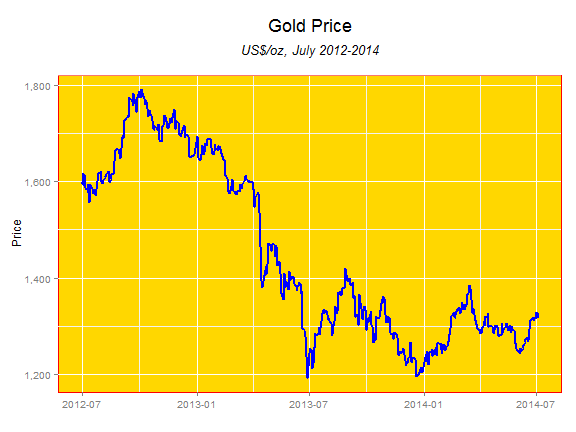
Correlations
The graph below suggests a relationship between daily tweet volumes and daily returns
data <- merge(pdata.df,gt,by="date",all=TRUE) #dataframe "gt" merged with price data plot(data$r, data$tw, main = "Daily Gold Price Returns vs. Daily Tweet Volume", xlab = "Return", ylab = "Tweets")
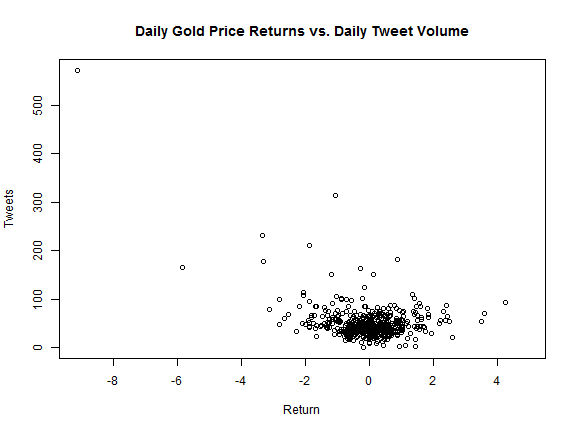
Also, the graph below suggests a relationship between daily tweet volumes and daily volatility
plot(data$ar, data$tw, main = "Daily Gold Price Returns vs. Daily Tweet Volatility", xlab = "Return", ylab = "Tweets")
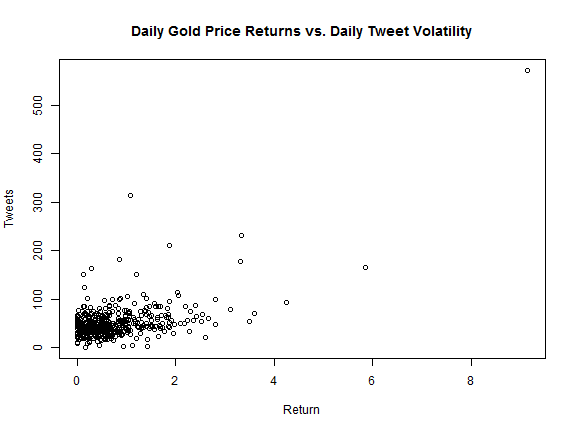
The dataset is split into two groups, data1 and data2, due to a large gap in the time series data.
data1 <- data[data$date < as.Date("2013-08-10"),] data1$tw <- na.approx(data1$tw) #fill in sporadic missing data data1$wtw <- na.approx(data1$wtw) #fill in sporadic missing data data2 <- data[data$date > as.Date("2013-10-03") & data$date < as.Date("2014-07-01"),]
In data1, the range of returns (r), volatility (ar), and tweet volumes (tw) is larger than in data2.
summary(data1[2:4])
## r ar tw ## Min. :-9.150 Min. :0.000 Min. : 0.0 ## 1st Qu.:-0.479 1st Qu.:0.200 1st Qu.: 40.0 ## Median : 0.000 Median :0.450 Median : 50.0 ## Mean :-0.063 Mean :0.735 Mean : 58.9 ## 3rd Qu.: 0.446 3rd Qu.:0.985 3rd Qu.: 67.0 ## Max. : 4.262 Max. :9.150 Max. :573.0
summary(data2[2:4])
## r ar tw ## Min. :-2.816 Min. :0.000 Min. : 9 ## 1st Qu.:-0.558 1st Qu.:0.275 1st Qu.: 26 ## Median : 0.076 Median :0.577 Median : 36 ## Mean : 0.004 Mean :0.729 Mean : 37 ## 3rd Qu.: 0.573 3rd Qu.:0.968 3rd Qu.: 44 ## Max. : 3.596 Max. :3.596 Max. :100
In both datasets tweets are autocorrelated
acf(data1$tw)
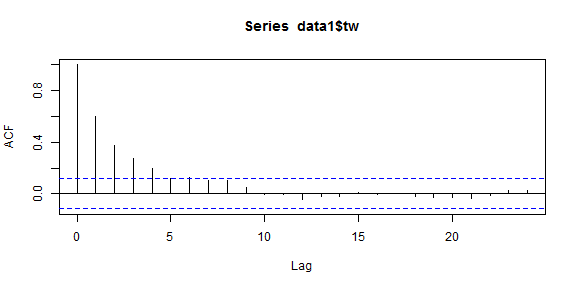
acf(data2$tw)
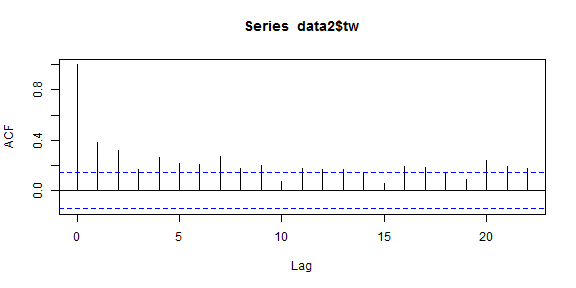
Differencing the tweets so that autocorrelation disappears:
data1$tw.diff <- c(NA,diff(data1$tw, lag = 1, differences = 1)) data2$tw.diff <- c(NA,diff(data2$tw, lag = 1, differences = 1)) acf(na.omit(data1$tw.diff))
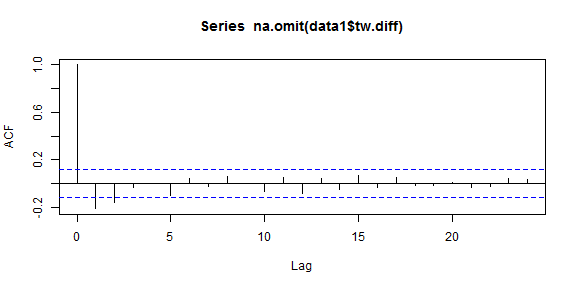
acf(na.omit(data2$tw.diff))
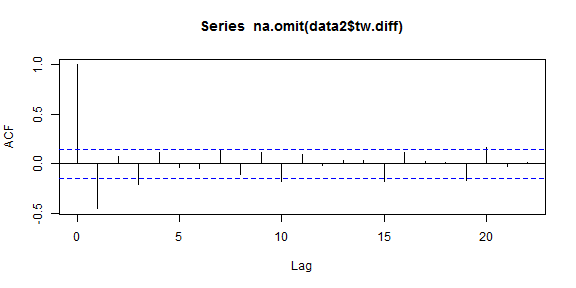
The series tw.diff is AR(1), so regressions of returns and volatility as a function of the change in tweets and the lagged value of change in tweets is a reasonable approach.
Tweet Volume and Daily Price Returns
An OLS regression of daily price returns as a function of the change in tweet volumes, same day and previous day, results in the following:
modR.data1 <- lm(r~tw.diff + lag(tw.diff), data1) modR.data2 <- lm(r~tw.diff + lag(tw.diff), data2) summary(modR.data1)
## ## Call: ## lm(formula = r ~ tw.diff + lag(tw.diff), data = data1) ## ## Residuals: ## Min 1Q Median 3Q Max ## -4.107 -0.485 -0.047 0.512 3.195 ## ## Coefficients: ## Estimate Std. Error t value Pr(>|t|) ## (Intercept) -0.06846 0.05931 -1.15 0.25 ## tw.diff -0.01474 0.00150 -9.82 < 2e-16 *** ## lag(tw.diff) -0.00807 0.00150 -5.37 1.6e-07 *** ## --- ## Signif. codes: 0 '***' 0.001 '**' 0.01 '*' 0.05 '.' 0.1 ' ' 1 ## ## Residual standard error: 0.998 on 280 degrees of freedom ## (2 observations deleted due to missingness) ## Multiple R-squared: 0.278, Adjusted R-squared: 0.273 ## F-statistic: 53.9 on 2 and 280 DF, p-value: <2e-16
summary(modR.data2)
## ## Call: ## lm(formula = r ~ tw.diff + lag(tw.diff), data = data2) ## ## Residuals: ## Min 1Q Median 3Q Max ## -2.854 -0.596 0.049 0.540 3.568 ## ## Coefficients: ## Estimate Std. Error t value Pr(>|t|) ## (Intercept) 0.000501 0.070611 0.01 0.99 ## tw.diff -0.001463 0.004863 -0.30 0.76 ## lag(tw.diff) -0.003325 0.004865 -0.68 0.50 ## ## Residual standard error: 0.96 on 182 degrees of freedom ## (2 observations deleted due to missingness) ## Multiple R-squared: 0.00256, Adjusted R-squared: -0.0084 ## F-statistic: 0.234 on 2 and 182 DF, p-value: 0.792
The coefficients of the model for data1 are more significant than those for data2. Also, the p-values of the coefficients are smaller in the model for data1 than in the case of data2. The model for data2 does not allow us to negate the null hypothesis that the coefficient for the previous day's tweets is significantly different than zero.
There seems to be some heteroscedasticity of the error terms in the model for data1, most likely because the model is having difficulty working with the observations with large negative returns/tweet volume. Heteroscedasticity does not seem to be a problem with data2.
plot(modR.data1)
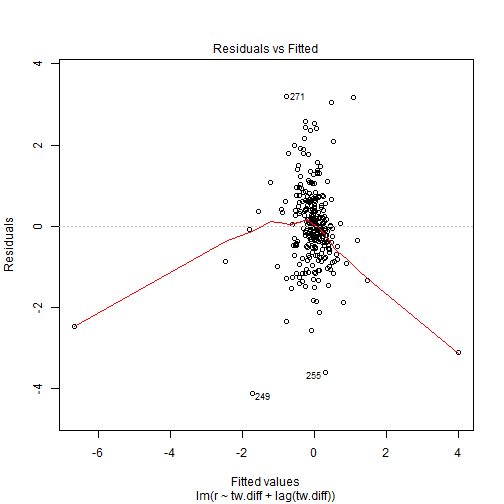
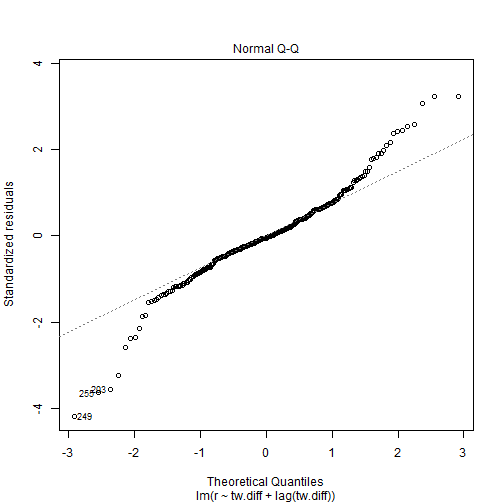
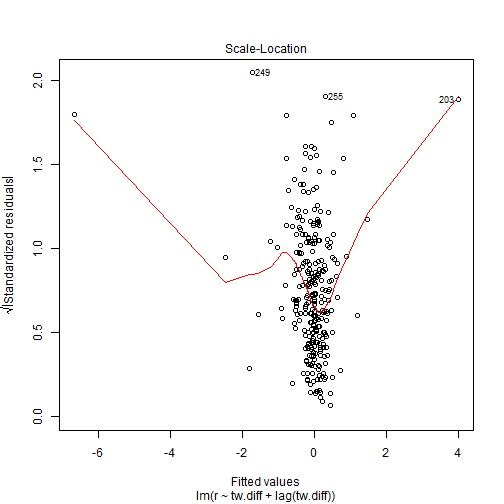
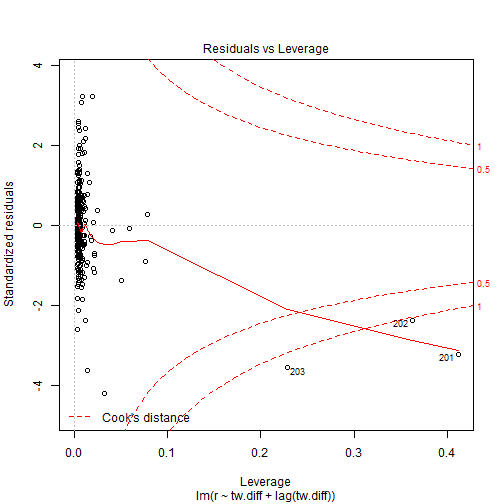
plot(modR.data2)
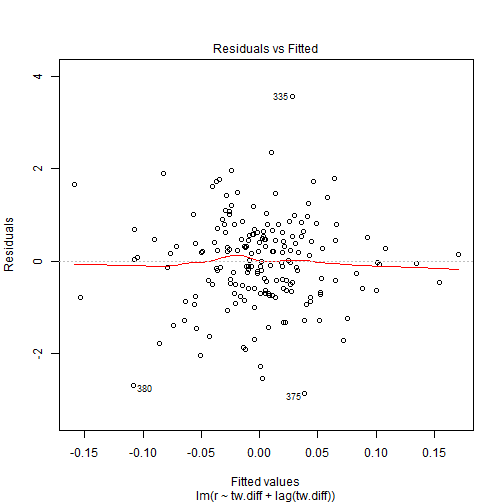
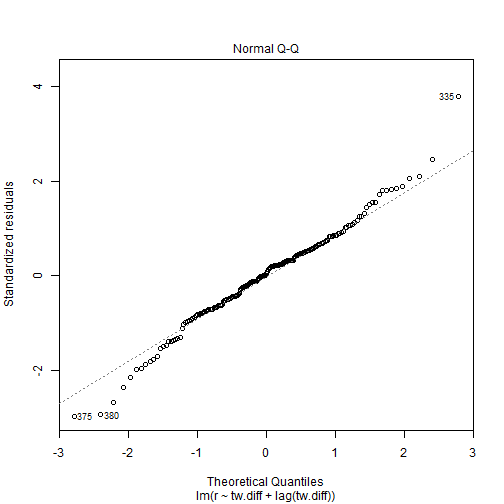
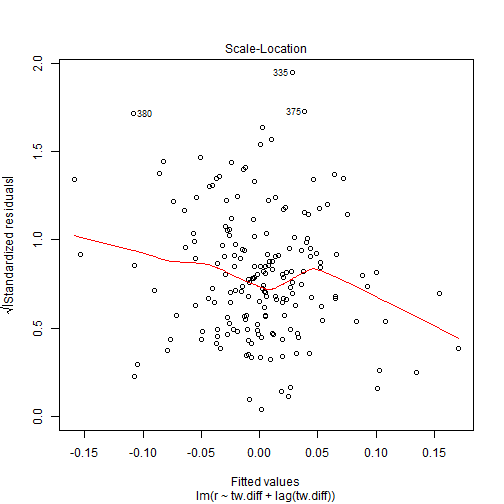
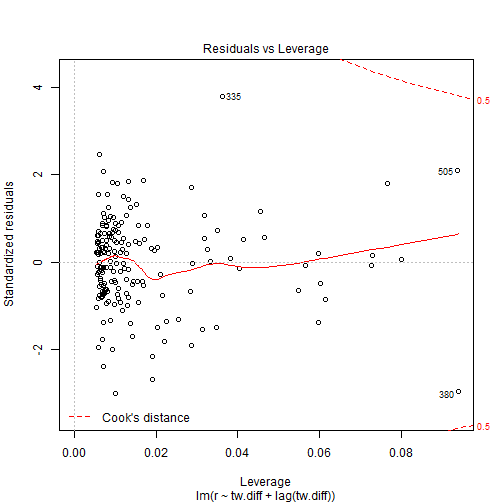
Using a robust covariance matrix estimator for data1 to test the coefficients of the model shows that the coefficient for the previous day's change in tweets is significant at the 10% confidence interval.
library(sandwich) library(lmtest) vcovHC(modR.data1)
## (Intercept) tw.diff lag(tw.diff) ## (Intercept) 3.839e-03 3.777e-05 1.476e-05 ## tw.diff 3.777e-05 2.114e-05 1.077e-05 ## lag(tw.diff) 1.476e-05 1.077e-05 1.731e-05
coeftest(modR.data1, vcov. = vcovHC)
## ## t test of coefficients: ## ## Estimate Std. Error t value Pr(>|t|) ## (Intercept) -0.06846 0.06196 -1.10 0.2702 ## tw.diff -0.01474 0.00460 -3.21 0.0015 ** ## lag(tw.diff) -0.00807 0.00416 -1.94 0.0536 . ## --- ## Signif. codes: 0 '***' 0.001 '**' 0.01 '*' 0.05 '.' 0.1 ' ' 1
Including the variable "wtw" (weekend and holiday tweets) does not seem to add explanatory value for the model for data1 but it does for data2 (at 5% confidence interval):
modRwtw.data1 <- lm(r~tw.diff + lag(tw.diff) + wtw, data1) modRwtw.data2 <- lm(r~tw.diff + lag(tw.diff) + wtw, data2) summary(modRwtw.data1)
## ## Call: ## lm(formula = r ~ tw.diff + lag(tw.diff) + wtw, data = data1) ## ## Residuals: ## Min 1Q Median 3Q Max ## -4.047 -0.520 -0.023 0.496 3.079 ## ## Coefficients: ## Estimate Std. Error t value Pr(>|t|) ## (Intercept) -0.10418 0.06444 -1.62 0.11 ## tw.diff -0.01496 0.00151 -9.93 < 2e-16 *** ## lag(tw.diff) -0.00810 0.00150 -5.40 1.4e-07 *** ## wtw 0.00570 0.00406 1.40 0.16 ## --- ## Signif. codes: 0 '***' 0.001 '**' 0.01 '*' 0.05 '.' 0.1 ' ' 1 ## ## Residual standard error: 0.996 on 279 degrees of freedom ## (2 observations deleted due to missingness) ## Multiple R-squared: 0.283, Adjusted R-squared: 0.275 ## F-statistic: 36.7 on 3 and 279 DF, p-value: <2e-16
summary(modRwtw.data2)
## ## Call: ## lm(formula = r ~ tw.diff + lag(tw.diff) + wtw, data = data2) ## ## Residuals: ## Min 1Q Median 3Q Max ## -2.770 -0.539 -0.021 0.554 3.637 ## ## Coefficients: ## Estimate Std. Error t value Pr(>|t|) ## (Intercept) -0.079766 0.076768 -1.04 0.300 ## tw.diff -0.000729 0.004804 -0.15 0.880 ## lag(tw.diff) -0.002670 0.004804 -0.56 0.579 ## wtw 0.016135 0.006499 2.48 0.014 * ## --- ## Signif. codes: 0 '***' 0.001 '**' 0.01 '*' 0.05 '.' 0.1 ' ' 1 ## ## Residual standard error: 0.947 on 181 degrees of freedom ## (2 observations deleted due to missingness) ## Multiple R-squared: 0.0354, Adjusted R-squared: 0.0194 ## F-statistic: 2.22 on 3 and 181 DF, p-value: 0.0879
Tweet Volume and Daily Price Volatility
OLS regressions of daily volatility as a function of the change in tweet volumes, same day and previous day, show that the change in the previous day's tweet volumes has significant coefficients. Furthermore, the difference between these coefficients data1 and data2 is small.
modV.data1 <- lm(ar~tw.diff + lag(tw.diff), data1) modV.data2 <- lm(ar~tw.diff + lag(tw.diff), data2) summary(modV.data1)
## ## Call: ## lm(formula = ar ~ tw.diff + lag(tw.diff), data = data1) ## ## Residuals: ## Min 1Q Median 3Q Max ## -1.474 -0.474 -0.197 0.239 4.449 ## ## Coefficients: ## Estimate Std. Error t value Pr(>|t|) ## (Intercept) 0.73386 0.04652 15.78 <2e-16 *** ## tw.diff 0.01165 0.00118 9.89 <2e-16 *** ## lag(tw.diff) 0.00530 0.00118 4.50 1e-05 *** ## --- ## Signif. codes: 0 '***' 0.001 '**' 0.01 '*' 0.05 '.' 0.1 ' ' 1 ## ## Residual standard error: 0.783 on 280 degrees of freedom ## (2 observations deleted due to missingness) ## Multiple R-squared: 0.271, Adjusted R-squared: 0.265 ## F-statistic: 51.9 on 2 and 280 DF, p-value: <2e-16
summary(modV.data2)
## ## Call: ## lm(formula = ar ~ tw.diff + lag(tw.diff), data = data2) ## ## Residuals: ## Min 1Q Median 3Q Max ## -0.9459 -0.4019 -0.0917 0.1932 2.3603 ## ## Coefficients: ## Estimate Std. Error t value Pr(>|t|) ## (Intercept) 0.73058 0.04164 17.55 < 2e-16 *** ## tw.diff 0.01724 0.00287 6.01 9.9e-09 *** ## lag(tw.diff) 0.00598 0.00287 2.08 0.039 * ## --- ## Signif. codes: 0 '***' 0.001 '**' 0.01 '*' 0.05 '.' 0.1 ' ' 1 ## ## Residual standard error: 0.566 on 182 degrees of freedom ## (2 observations deleted due to missingness) ## Multiple R-squared: 0.168, Adjusted R-squared: 0.159 ## F-statistic: 18.3 on 2 and 182 DF, p-value: 5.59e-08
Again, there seems to be heteroscedasticity of the error terms in the model for data1, and less so for data2.
plot(modV.data1)
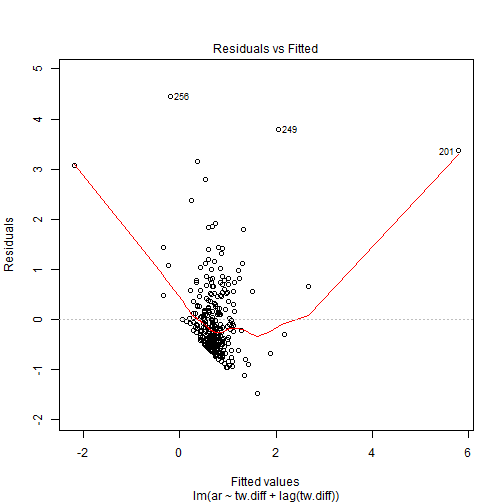
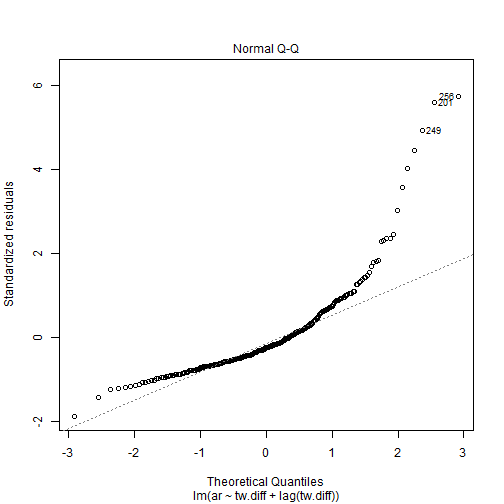
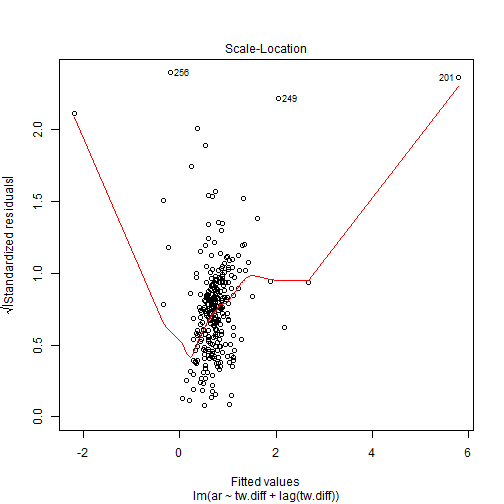
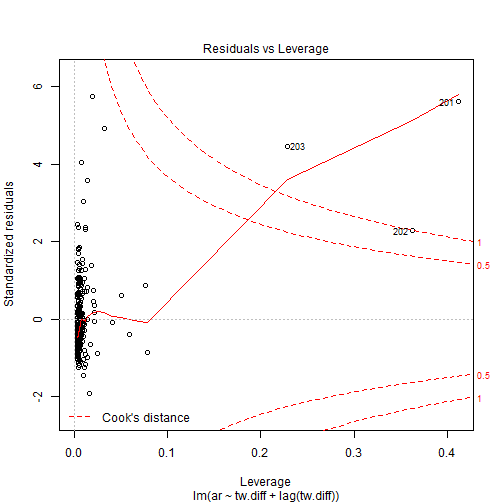
plot(modV.data2)
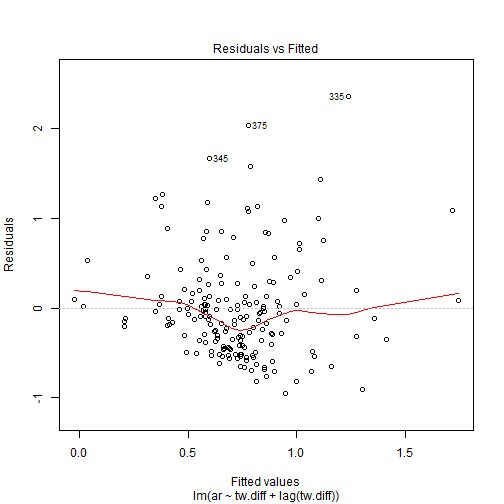
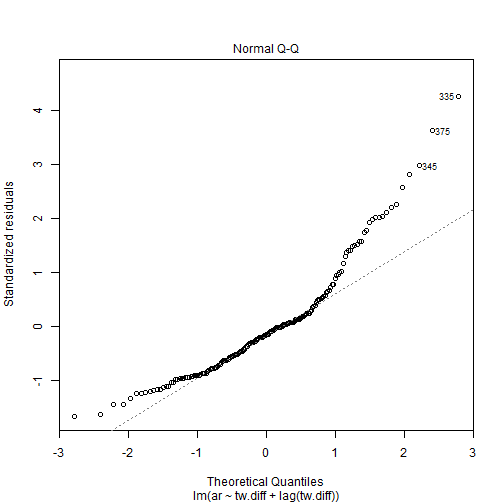
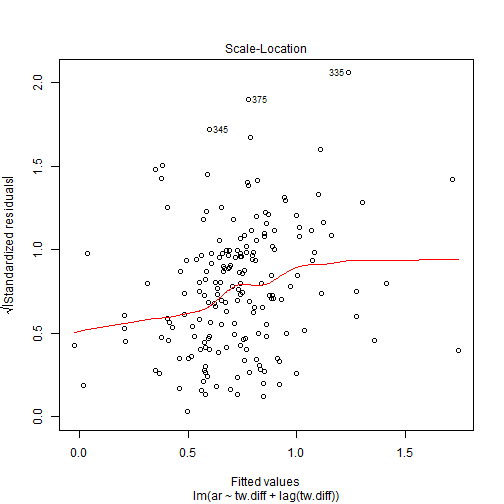
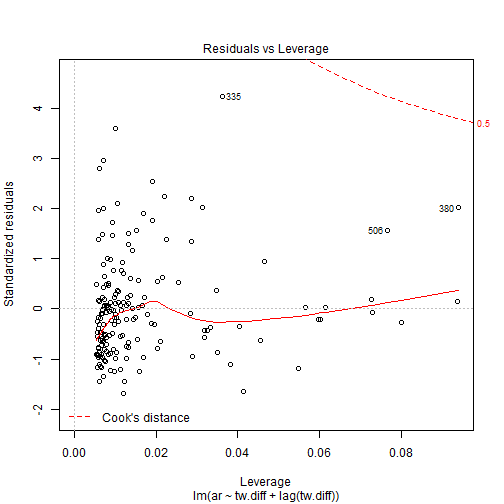
Using a robust covariance matrix estimator to test the coefficients of the models shows that the coefficient for the previous day's tweets is significant at the 5% confidence interval for data2, but not data1.
coeftest(modV.data1, vcov. = vcovHC)
## ## t test of coefficients: ## ## Estimate Std. Error t value Pr(>|t|) ## (Intercept) 0.73386 0.05075 14.46 <2e-16 *** ## tw.diff 0.01165 0.00568 2.05 0.041 * ## lag(tw.diff) 0.00530 0.00434 1.22 0.224 ## --- ## Signif. codes: 0 '***' 0.001 '**' 0.01 '*' 0.05 '.' 0.1 ' ' 1
coeftest(modV.data2, vcov. = vcovHC)
## ## t test of coefficients: ## ## Estimate Std. Error t value Pr(>|t|) ## (Intercept) 0.73058 0.04220 17.31 < 2e-16 *** ## tw.diff 0.01724 0.00344 5.01 1.3e-06 *** ## lag(tw.diff) 0.00598 0.00281 2.13 0.035 * ## --- ## Signif. codes: 0 '***' 0.001 '**' 0.01 '*' 0.05 '.' 0.1 ' ' 1
Including the variable "wtw" (weekend and holiday tweets) adds some explanatory value for data1 but not for data2:
modVwtw.data1 <- lm(ar~tw.diff + lag(tw.diff) + wtw, data1) modVwtw.data2 <- lm(ar~tw.diff + lag(tw.diff) + wtw, data2) summary(modVwtw.data1)
## ## Call: ## lm(formula = ar ~ tw.diff + lag(tw.diff) + wtw, data = data1) ## ## Residuals: ## Min 1Q Median 3Q Max ## -1.407 -0.465 -0.210 0.255 4.088 ## ## Coefficients: ## Estimate Std. Error t value Pr(>|t|) ## (Intercept) 0.68661 0.05021 13.67 <2e-16 *** ## tw.diff 0.01136 0.00117 9.68 <2e-16 *** ## lag(tw.diff) 0.00525 0.00117 4.49 1e-05 *** ## wtw 0.00754 0.00316 2.38 0.018 * ## --- ## Signif. codes: 0 '***' 0.001 '**' 0.01 '*' 0.05 '.' 0.1 ' ' 1 ## ## Residual standard error: 0.776 on 279 degrees of freedom ## (2 observations deleted due to missingness) ## Multiple R-squared: 0.285, Adjusted R-squared: 0.277 ## F-statistic: 37.1 on 3 and 279 DF, p-value: <2e-16
summary(modVwtw.data2)
## ## Call: ## lm(formula = ar ~ tw.diff + lag(tw.diff) + wtw, data = data2) ## ## Residuals: ## Min 1Q Median 3Q Max ## -0.9587 -0.3936 -0.0927 0.2033 2.3678 ## ## Coefficients: ## Estimate Std. Error t value Pr(>|t|) ## (Intercept) 0.72179 0.04601 15.69 < 2e-16 *** ## tw.diff 0.01732 0.00288 6.01 9.8e-09 *** ## lag(tw.diff) 0.00605 0.00288 2.10 0.037 * ## wtw 0.00177 0.00389 0.45 0.650 ## --- ## Signif. codes: 0 '***' 0.001 '**' 0.01 '*' 0.05 '.' 0.1 ' ' 1 ## ## Residual standard error: 0.568 on 181 degrees of freedom ## (2 observations deleted due to missingness) ## Multiple R-squared: 0.169, Adjusted R-squared: 0.155 ## F-statistic: 12.2 on 3 and 181 DF, p-value: 2.51e-07
Conclusion
In this dataset, the change in tweet volumes was not a leading indicator of daily price returns. But the change in tweet volumes did show some indications of being a leading indicator of daily price volatility. The addition of weekend and holiday tweet volumes did not help predict either daily returns or volatility.